Jianfeng Xiang
MoGe-2: Accurate Monocular Geometry with Metric Scale and Sharp Details
Jul 03, 2025


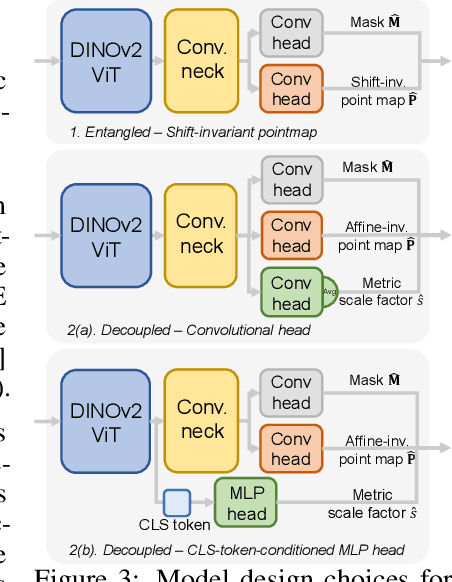
Abstract:We propose MoGe-2, an advanced open-domain geometry estimation model that recovers a metric scale 3D point map of a scene from a single image. Our method builds upon the recent monocular geometry estimation approach, MoGe, which predicts affine-invariant point maps with unknown scales. We explore effective strategies to extend MoGe for metric geometry prediction without compromising the relative geometry accuracy provided by the affine-invariant point representation. Additionally, we discover that noise and errors in real data diminish fine-grained detail in the predicted geometry. We address this by developing a unified data refinement approach that filters and completes real data from different sources using sharp synthetic labels, significantly enhancing the granularity of the reconstructed geometry while maintaining the overall accuracy. We train our model on a large corpus of mixed datasets and conducted comprehensive evaluations, demonstrating its superior performance in achieving accurate relative geometry, precise metric scale, and fine-grained detail recovery -- capabilities that no previous methods have simultaneously achieved.
Structured 3D Latents for Scalable and Versatile 3D Generation
Dec 02, 2024



Abstract:We introduce a novel 3D generation method for versatile and high-quality 3D asset creation. The cornerstone is a unified Structured LATent (SLAT) representation which allows decoding to different output formats, such as Radiance Fields, 3D Gaussians, and meshes. This is achieved by integrating a sparsely-populated 3D grid with dense multiview visual features extracted from a powerful vision foundation model, comprehensively capturing both structural (geometry) and textural (appearance) information while maintaining flexibility during decoding. We employ rectified flow transformers tailored for SLAT as our 3D generation models and train models with up to 2 billion parameters on a large 3D asset dataset of 500K diverse objects. Our model generates high-quality results with text or image conditions, significantly surpassing existing methods, including recent ones at similar scales. We showcase flexible output format selection and local 3D editing capabilities which were not offered by previous models. Code, model, and data will be released.
MoGe: Unlocking Accurate Monocular Geometry Estimation for Open-Domain Images with Optimal Training Supervision
Oct 24, 2024



Abstract:We present MoGe, a powerful model for recovering 3D geometry from monocular open-domain images. Given a single image, our model directly predicts a 3D point map of the captured scene with an affine-invariant representation, which is agnostic to true global scale and shift. This new representation precludes ambiguous supervision in training and facilitate effective geometry learning. Furthermore, we propose a set of novel global and local geometry supervisions that empower the model to learn high-quality geometry. These include a robust, optimal, and efficient point cloud alignment solver for accurate global shape learning, and a multi-scale local geometry loss promoting precise local geometry supervision. We train our model on a large, mixed dataset and demonstrate its strong generalizability and high accuracy. In our comprehensive evaluation on diverse unseen datasets, our model significantly outperforms state-of-the-art methods across all tasks, including monocular estimation of 3D point map, depth map, and camera field of view. Code and models will be released on our project page.
Diffusion Models are Geometry Critics: Single Image 3D Editing Using Pre-Trained Diffusion Priors
Mar 18, 2024Abstract:We propose a novel image editing technique that enables 3D manipulations on single images, such as object rotation and translation. Existing 3D-aware image editing approaches typically rely on synthetic multi-view datasets for training specialized models, thus constraining their effectiveness on open-domain images featuring significantly more varied layouts and styles. In contrast, our method directly leverages powerful image diffusion models trained on a broad spectrum of text-image pairs and thus retain their exceptional generalization abilities. This objective is realized through the development of an iterative novel view synthesis and geometry alignment algorithm. The algorithm harnesses diffusion models for dual purposes: they provide appearance prior by predicting novel views of the selected object using estimated depth maps, and they act as a geometry critic by correcting misalignments in 3D shapes across the sampled views. Our method can generate high-quality 3D-aware image edits with large viewpoint transformations and high appearance and shape consistency with the input image, pushing the boundaries of what is possible with single-image 3D-aware editing.
AniPortraitGAN: Animatable 3D Portrait Generation from 2D Image Collections
Sep 05, 2023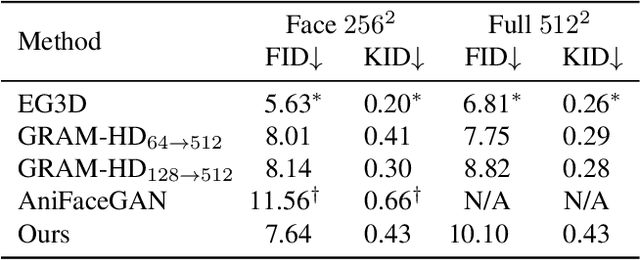
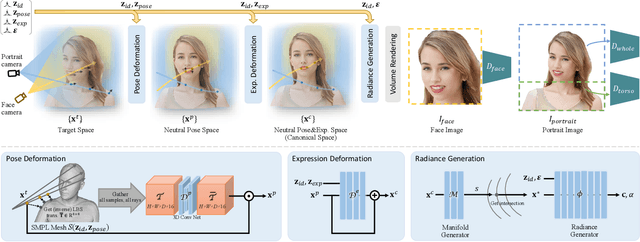
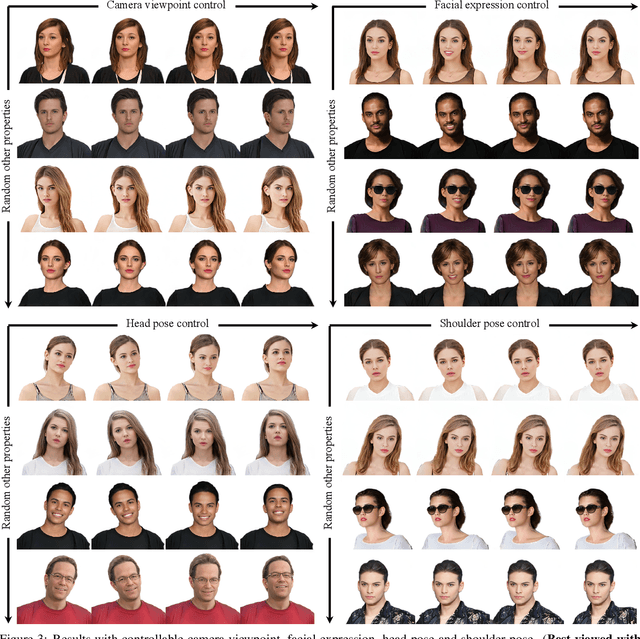
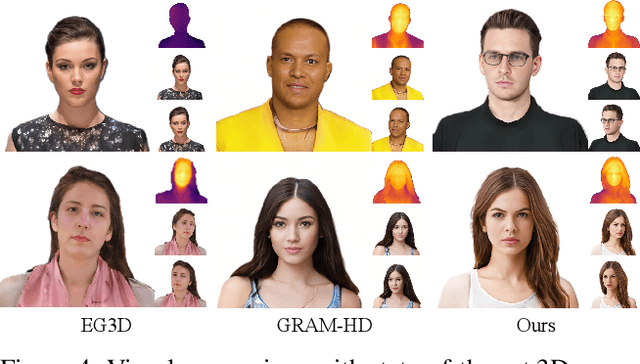
Abstract:Previous animatable 3D-aware GANs for human generation have primarily focused on either the human head or full body. However, head-only videos are relatively uncommon in real life, and full body generation typically does not deal with facial expression control and still has challenges in generating high-quality results. Towards applicable video avatars, we present an animatable 3D-aware GAN that generates portrait images with controllable facial expression, head pose, and shoulder movements. It is a generative model trained on unstructured 2D image collections without using 3D or video data. For the new task, we base our method on the generative radiance manifold representation and equip it with learnable facial and head-shoulder deformations. A dual-camera rendering and adversarial learning scheme is proposed to improve the quality of the generated faces, which is critical for portrait images. A pose deformation processing network is developed to generate plausible deformations for challenging regions such as long hair. Experiments show that our method, trained on unstructured 2D images, can generate diverse and high-quality 3D portraits with desired control over different properties.
3D-aware Image Generation using 2D Diffusion Models
Mar 31, 2023Abstract:In this paper, we introduce a novel 3D-aware image generation method that leverages 2D diffusion models. We formulate the 3D-aware image generation task as multiview 2D image set generation, and further to a sequential unconditional-conditional multiview image generation process. This allows us to utilize 2D diffusion models to boost the generative modeling power of the method. Additionally, we incorporate depth information from monocular depth estimators to construct the training data for the conditional diffusion model using only still images. We train our method on a large-scale dataset, i.e., ImageNet, which is not addressed by previous methods. It produces high-quality images that significantly outperform prior methods. Furthermore, our approach showcases its capability to generate instances with large view angles, even though the training images are diverse and unaligned, gathered from "in-the-wild" real-world environments.
GRAM-HD: 3D-Consistent Image Generation at High Resolution with Generative Radiance Manifolds
Jun 15, 2022

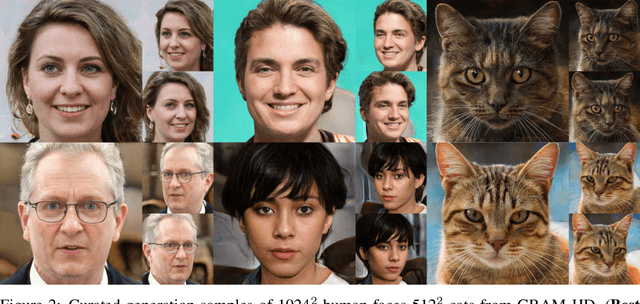

Abstract:Recent works have shown that 3D-aware GANs trained on unstructured single image collections can generate multiview images of novel instances. The key underpinnings to achieve this are a 3D radiance field generator and a volume rendering process. However, existing methods either cannot generate high-resolution images (e.g., up to 256X256) due to the high computation cost of neural volume rendering, or rely on 2D CNNs for image-space upsampling which jeopardizes the 3D consistency across different views. This paper proposes a novel 3D-aware GAN that can generate high resolution images (up to 1024X1024) while keeping strict 3D consistency as in volume rendering. Our motivation is to achieve super-resolution directly in the 3D space to preserve 3D consistency. We avoid the otherwise prohibitively-expensive computation cost by applying 2D convolutions on a set of 2D radiance manifolds defined in the recent generative radiance manifold (GRAM) approach, and apply dedicated loss functions for effective GAN training at high resolution. Experiments on FFHQ and AFHQv2 datasets show that our method can produce high-quality 3D-consistent results that significantly outperform existing methods.
Contrastive learning of Class-agnostic Activation Map for Weakly Supervised Object Localization and Semantic Segmentation
Mar 25, 2022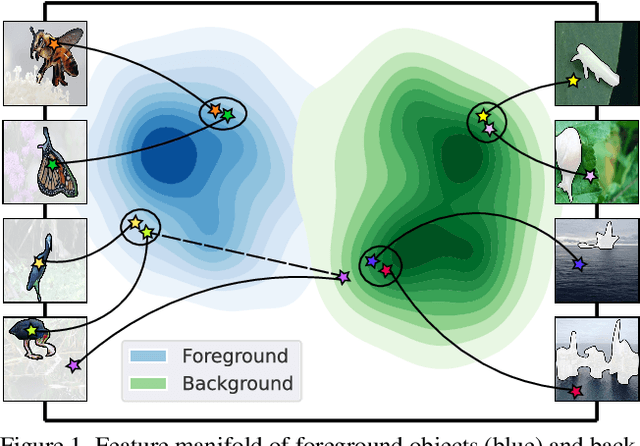
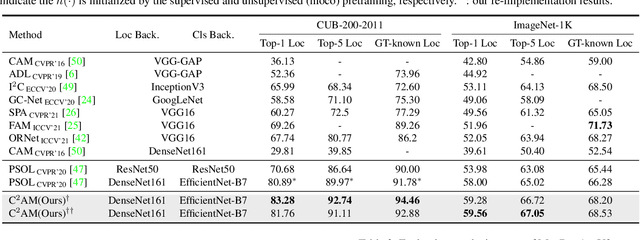
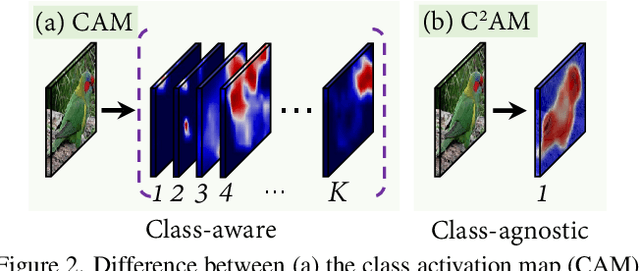
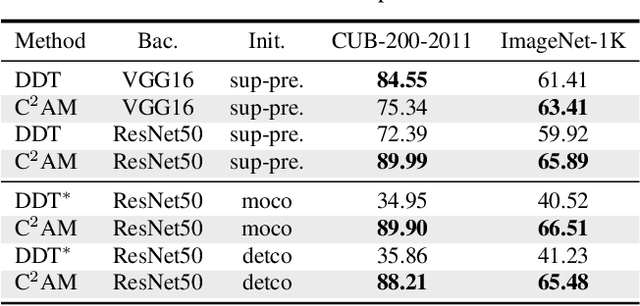
Abstract:While class activation map (CAM) generated by image classification network has been widely used for weakly supervised object localization (WSOL) and semantic segmentation (WSSS), such classifiers usually focus on discriminative object regions. In this paper, we propose Contrastive learning for Class-agnostic Activation Map (C$^2$AM) generation only using unlabeled image data, without the involvement of image-level supervision. The core idea comes from the observation that i) semantic information of foreground objects usually differs from their backgrounds; ii) foreground objects with similar appearance or background with similar color/texture have similar representations in the feature space. We form the positive and negative pairs based on the above relations and force the network to disentangle foreground and background with a class-agnostic activation map using a novel contrastive loss. As the network is guided to discriminate cross-image foreground-background, the class-agnostic activation maps learned by our approach generate more complete object regions. We successfully extracted from C$^2$AM class-agnostic object bounding boxes for object localization and background cues to refine CAM generated by classification network for semantic segmentation. Extensive experiments on CUB-200-2011, ImageNet-1K, and PASCAL VOC2012 datasets show that both WSOL and WSSS can benefit from the proposed C$^2$AM.
GRAM: Generative Radiance Manifolds for 3D-Aware Image Generation
Dec 17, 2021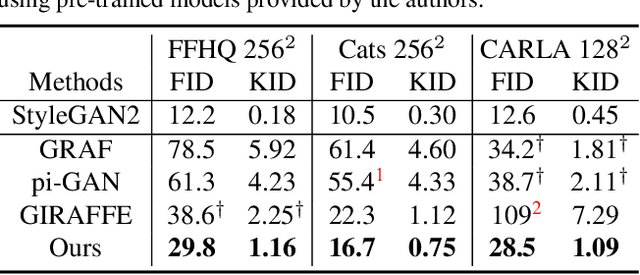
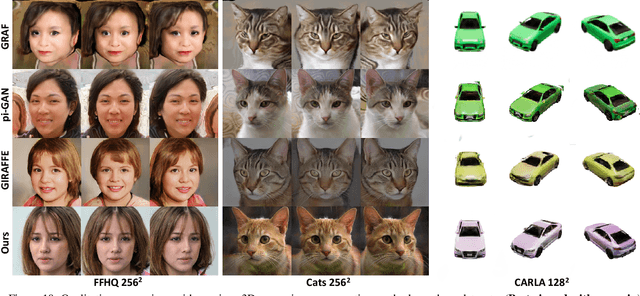
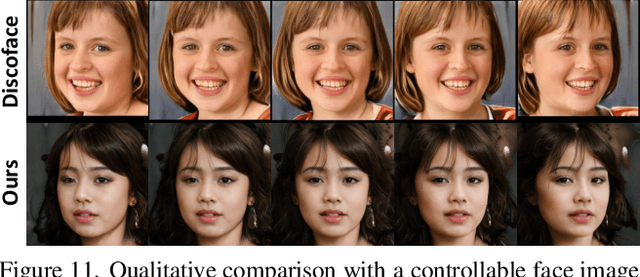
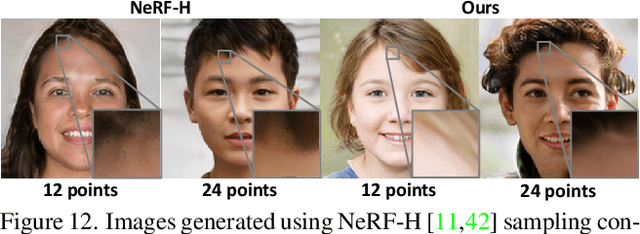
Abstract:3D-aware image generative modeling aims to generate 3D-consistent images with explicitly controllable camera poses. Recent works have shown promising results by training neural radiance field (NeRF) generators on unstructured 2D images, but still can not generate highly-realistic images with fine details. A critical reason is that the high memory and computation cost of volumetric representation learning greatly restricts the number of point samples for radiance integration during training. Deficient sampling not only limits the expressive power of the generator to handle fine details but also impedes effective GAN training due to the noise caused by unstable Monte Carlo sampling. We propose a novel approach that regulates point sampling and radiance field learning on 2D manifolds, embodied as a set of learned implicit surfaces in the 3D volume. For each viewing ray, we calculate ray-surface intersections and accumulate their radiance generated by the network. By training and rendering such radiance manifolds, our generator can produce high quality images with realistic fine details and strong visual 3D consistency.
 Add to Chrome
Add to Chrome Add to Firefox
Add to Firefox Add to Edge
Add to Edge